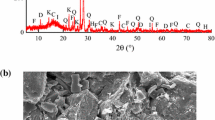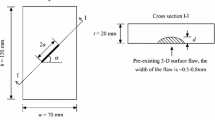Abstract
This study focuses on the effect of pre-existing flaw geometry on mechanical behavior and crack coalescence modes of sandstone specimens containing combined flaws with different fissure angle, ligament length and fissure length under uniaxial compression. The flaw geometry is a combination of a single hole and an inclined fissure underneath, which is generated by a high pressure water-jet cutting machine and is different from that reported in previous studies. The effect of flaw geometry on mechanical behavior of sandstone specimens is analyzed. Basically, mechanical parameters including the peak strength, peak axial strain, elastic modulus and secant Young’s modulus for the flawed specimens are lower than those for the intact specimens, with the reduction extent related to the fissure angle, ligament length and fissure length. Variation trends of the crack initiation stress for all tested cases are studied. Initiated crack types and cracking modes also depend on the combined flaws geometry. For the flawed specimens with a small fissure angle, ligament length or fissure length, cracking modes are generally characterized by cracks initiated from the hole-wall and evolved to the specimen boundary. However, when the fissure angle, ligament length or fissure length is increased, cracks initiated from both the hole-wall and fissure tips produce the main failure planes, accompanied by a free-standing “triangular prism structure” within the specimens. Numerical simulations using RFPA2D (Rock Failure Process Analysis in two dimensions) are carried out on the flawed sandstone specimens and agree well with the experimental results in the peak strength and overall cracking behavior.
Similar content being viewed by others
References
Aliabadi, M.H. and Brebbia, C.A., 1993, Advances in boundary element methods for fracture mechanics. Computational Mechanics Publications, Southampton, Co-published with Elsevier Applied Science, London, 292 p.
Belytschko, T. and Black, T., 1999, Elastic crack growth in finite elements with minimal remeshing. International Journal for Numerical Methods in Engineering, 45, 601–620.
Bobet, A. and Einstein, H.H., 1998, Fracture coalescence in rock-type materials under uniaxial and biaxial compression. International Journal of Rock Mechanics and Mining Sciences, 35, 863–888.
Bouchard, P.O., Bay, F., and Chastel, Y., 2003, Numerical modelling of crack propagation: automatic remeshing and comparison of different criteria. Computer Methods in Applied Mechanics and Engineering, 192, 3887–3908.
Cai, M., Kaiser, P.K., Tasaka, Y., Maejima, T., Morioka, H., and Minami, M., 2004, Generalized crack initiation and crack damage stress thresholds of brittle rock masses near underground excavations. International Journal of Rock Mechanics and Mining Sciences, 41, 833–847.
Chen, X.G., Zhang, Q.Y., Yang, W.D., Li, S.C., Liu, D.J., and Wang, H.P., 2011, Comparative analyses of model tests and in-situ monitoring of zonal disintegration or rock mass in deep tunnels. Chinese Journal of Geotechnical Engineering, 33, 70–76. (in Chinese)
Feng, X.T., Ding, W.X., and Zhang, D.X., 2009, Multi-crack interaction in limestone subject to stress and flow of chemical solutions. International Journal of Rock Mechanics and Mining Sciences, 46, 159–171.
Haeri, H., Shahriar, K., Marji, M.F., and Moarefvand, P., 2014a, Cracks coalescence mechanism and cracks propagation paths in rock-like specimens containing pre-existing random cracks under compression. Journal of Central South University, 21, 2404–2414.
Haeri, H., Shahriar, K., Marji, M.F., and Moarefvand, P., 2014b, On the crack propagation analysis of rock like Brazilian disc specimens containing cracks under compressive loading. Latin American Journal of Solids and Structures, 11, 1400–1416.
Haeri, H., Khaloo, A., and Marji, M.F., 2015, Fracture analyses of different pre-holed concrete specimens under compression. Acta Mechanica Sinica, 31, 855–870.
Huang, D., Gu, D.M., Yang, C., Huang, R.Q., and Fu, G.Y., 2016, Investigation on mechanical behaviors of sandstone with two preexisting flaws under triaxial compression. Rock Mechanics and Rock Engineering, 49, 375–399.
Iturrioz, I., Miguel, L.F.F., and Riera, J.D., 2009, Dynamic fracture analysis of concrete or rock plates by means of the discrete element method. Latin American Journal of Solids and Structures, 6, 229–245.
Lee, H. and Jeon, S., 2011, An experimental and numerical study of fracture coalescence in pre-cracked specimens under uniaxial compression. International Journal of Solids and Structures, 48, 979–999.
Li, Y.P., Chen, L.Z., and Wang, Y.H., 2005, Experimental research on pre-cracked marble under compression. International Journal of Solids and Structures, 42, 2505–2516.
Li, Y.R., Huang, D., and Li, X.A., 2014, Strain rate dependency of coarse crystal marble under uniaxial compression: strength, deformation and strain energy. Rock Mechanics and Rock Engineering, 47, 1153–1164.
Li, Y., Peng, J., Zhang, F., and Qiu, Z., 2016, Cracking behavior and mechanism of sandstone containing a pre-cut hole under combined static and dynamic loading. Engineering Geology, 213, 64–73.
Lin, P., Wong, R.H.C., and Tang, C.A., 2015, Experimental study of coalescence mechanisms and failure under uniaxial compression of granite containing multiple holes. International Journal of Rock Mechanics & Mining Sciences, 77, 313–327.
Ma, G.W., An, X.M., Zhang, H.H., and Li, L.X., 2009, Modeling complex crack problems using the numerical manifold method. International Journal of Fracture, 156, 21–35.
Martin, C.D., 1993, The strength of massive Lac du Bonnet granite around underground openings. Ph.D. Thesis, University of Manitoba, Manitoba, 278 p.
Martin, C.D., 1997, Seventeenth Canadian Geotechnical Colloquium: The effect of cohesion loss and stress path on brittle rock strength. Canadian Geotechnical Journal, 34, 698–725.
Ning, Y.J., Yang, J., An, X.M., and Ma, G.W., 2011, Modelling rock fracturing and blast-induced rock mass failure via advanced discretisation within the discontinuous deformation analysis framework. Computers and Geotechnics, 38, 40–49.
Ooi, E.T., Song, C.M., Tin-Loi, F., and Yang, Z.J., 2012, Polygon scaled boundary finite elements for crack propagation modelling. International Journal for Numerical Methods in Engineering, 91, 319–342.
Park, C.H., 2008, Coalescence of frictional fractures in rock materials. Ph.D. Thesis, Purdue University, West Lafayette, 262 p.
Park, C.H. and Bobet, A., 2009, Crack coalescence in specimens with open and closed flaws: A comparison. International Journal of Rock Mechanics and Mining Sciences, 46, 819–829.
Park, C.H. and Bobet, A., 2010, Crack initiation, propagation and coalescence from frictional flaws in uniaxial compression. Engineering Fracture Mechanics, 77, 2727–2748.
Shen, B., 1995, The mechanism of fracture coalescence in compressionexperimental study and numerical simulation. Engineering Fracture Mechanics, 51, 73–85.
Tang, C.A., Lin, P., Wong, R.H.C., and Chau, K.T., 2001, Analysis of crack coalescence in rock-like materials containing three flaws-part II: numerical approach. International Journal of Rock Mechanics and Mining Sciences, 38, 925–939.
Tang, C.A., Yang, W.T., Fu, Y.F., and Xu, X.H., 1998, A new approach to numerical method of modelling geological processes and rock engineering problems–continuum to discontinuum and linearity to nonlinearity. Engineering Geology, 49, 207–214.
Trädegård, A., Nilsson, F., and Östlund, S., 1998, FEM-remeshing technique applied to crack growth problems. Computer Methods in Applied Mechanics and Engineering, 160, 115–131.
Van De Steen, B., Vervoort, A., and Napier, J.A.L., 2005, Observed and simulated fracture pattern in diametrically loaded discs of rock material. International Journal of Fracture, 131, 35–52.
Vesga, L.F., Vallejo, L.E., and Lobo-Guerrero, S., 2008, DEM analysis of the crack propagation in brittle clays under uniaxial compression tests. International Journal for Numerical and Analytical Methods in Geomechanics, 32, 1405–1415.
Wang, S.Y., Sloan, S.W., Sheng, D.C., and Tang, C.A., 2012, Numerical analysis of the failure process around a circular opening in rock. Computers and Geotechnics, 39, 8–16.
Wong, L.N.Y. and Einstein, H.H., 2009, Crack coalescence in molded gypsum and Carrara marble: Part 1. macroscopic observations and interpretation. Rock Mechanics and Rock Engineering, 42, 475–511.
Wong, R.H.C., Chau, K.T., Tang, C.A., and Lin, P., 2001, Analysis of crack coalescence in rock-like materials containing three flaws-Part I: experimental approach. International Journal of Rock Mechanics and Mining Sciences, 38, 909–924.
Wong, R.H.C., Tang, C.A., Chau, K.T., and Lin, P., 2002, Splitting failure in brittle rocks containing pre-existing flaws under uniaxial compression. Engineering Fracture Mechanics, 69, 1853–1871.
Wu, Z.J. and Wong, L.N.Y., 2012, Frictional crack initiation and propagation analysis using the numerical manifold method. Computers and Geotechnics, 39, 38–53.
Wu, Z.J. and Wong, L.N.Y., 2013, Modeling cracking behavior of rock mass containing inclusions using the enriched numerical manifold method. Engineering Geology, 162, 1–13.
Yang, S.Q., 2011, Crack coalescence behavior of brittle sandstone samples containing two coplanar fissures in the process of deformation failure. Engineering Fracture Mechanics, 78, 3059–3081.
Yang, S.Q., Jiang, Y.Z., Xu, W.Y., and Chen, X.Q., 2008, Experimental investigation on strength and failure behavior of pre-cracked mar ble under conventional triaxial compression. International Journal of Solids and Structures, 45, 4796–4819.
Yang, S.Q. and Jing, H.W., 2011, Strength failure and crack coalescence behavior of brittle sandstone samples containing a single fissure under uniaxial compression. International Journal of Fracture, 168, 227–250.
Yang, S.Q., Liu, X.R., and Jing, H.W., 2013, Experimental investigation on fracture coalescence behavior of red sandstone containing two unparallel fissures under uniaxial compression. International Journal of Rock Mechanics and Mining Sciences, 63, 82–92.
Yin, Q., Jing, H.W., and Ma, G.W., 2015, Experimental study on mechanical properties of sandstone specimens containing a single hole after high-temperature exposure. Geotechnique Letters, 5, 43–48.
Yin, Q., Jing, H.W., and Zhu, T.T., 2016, Mechanical behavior and failure analysis of granite specimens containing two orthogonal fissures under uniaxial compression. Arabian Journal of Geosciences. DOI 10.1007/s12517-015-2078-y
Zhao, G.F., Fang, J.N., and Zhao, J., 2011, A 3D distinct lattice spring model for elasticity and dynamic failure. International Journal for Numerical and Analytical Methods in Geomechanics, 35, 859–885.
Zhao, X.D., Zhang, H.X., and Zhu, W.C., 2014, Fracture evolution around pre-existing cylindrical cavities in brittle rocks under uniaxial compression. Transactions of Nonferrous Metals Society of China, 24, 806–815.
Zhao, Z.Y., Zhang, Y., and Bao, H.R., 2011, Tunnel blasting simulations by the discontinuous deformation analysis. International Journal of Computational Methods, 8, 277–292.
Zhu, T.T., Jing, H.W., Su, H.J., Yin, Q., and Du, M.R., 2015, Mechanical behavior of sandstone containing double circular cavities under uniaxial compression. Chinese Journal of Geotechnical Engineering, 37, 1047–1056. (in Chinese)
Zhu, W.C. and Tang, C.A., 2004, Micromechanical model for simulating the fracture process of rock. Rock Mechanics and Rock Engineering, 37, 25–56.
Author information
Authors and Affiliations
Corresponding author
Rights and permissions
About this article
Cite this article
Yin, Q., Jing, H. & Su, H. Investigation on mechanical behavior and crack coalescence of sandstone specimens containing fissure-hole combined flaws under uniaxial compression. Geosci J 22, 825–842 (2018). https://doi.org/10.1007/s12303-017-0081-x
Received:
Accepted:
Published:
Issue Date:
DOI: https://doi.org/10.1007/s12303-017-0081-x




